 W
WAmandine is a culinary term indicating a garnish of almonds. Dishes of this sort are usually cooked with butter and seasonings, then sprinkled with whole or flaked, toasted almonds. The term is often spelled almondine in American cookbooks.
 W
WBlackening is a cooking technique used in the preparation of fish and other foods. Often associated with Cajun cuisine, this technique was popularized by chef Paul Prudhomme. The food is dipped in melted butter and then sprinkled with a mixture of herbs and spices, usually some combination of thyme, oregano, chili pepper, peppercorns, salt, garlic powder and onion powder. It is then cooked in a very hot cast-iron skillet. The characteristic brown-black color of the crust results from a combination of browned milk solids from the butter and charred spices.
 W
WBlast chilling is a method of cooling food quickly to a low temperature that is relatively safe from bacterial growth. Bacteria multiply fastest between +8 °C (46 °F) and +68 °C (154 °F). By reducing the temperature of cooked food from +70 °C (158 °F) to +3 °C (37 °F) or below within 90 minutes, the food is rendered safe for storage and later consumption. This method of preserving food is commonly used in food catering and, recently, in the preparation of 'instant' foods, as it ensures the safety and the quality of the food product.
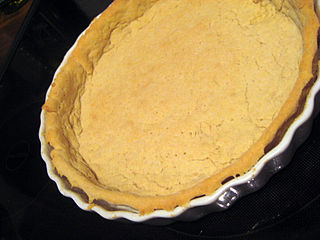 W
WBaking blind is the process of baking a pie crust or other pastry without the filling. Blind baking a pie crust is necessary when it will be filled with an unbaked filling, in which case the crust must be fully baked. It is also called for if the filling has a shorter bake time than the crust, in which case the crust is partly baked. Blind baking is also used to keep pie crust from becoming soggy due to a wet filling.
 W
WBrunoise is a culinary knife cut in which the food item is first julienned and then turned a quarter turn and diced, producing cubes of about 3 millimetres or less on each side. In France, a "brunoise" cut is a smaller 1 to 2mm. Some typical vegetables for a brunoise are carrots, celery, leeks, and turnips. The diced vegetables are blanched briefly in salty boiling water and then submerged in salted ice water for a few seconds to set the color. The brunoise is used as a garnish in many dishes; it is often used to garnish consommé. A brunoise should be consistent in size and shape, as this helps to create a pleasing and professional presentation.
 W
WButterflying is a way of preparing meat, fish, or poultry for cooking by cutting it almost in two, but leaving the two parts connected; it is then often boned and flattened. Spatchcocking is a specific method for butterflying poultry that involves removing the backbone, and spatchcock as a noun may refer to a bird prepared in that way.
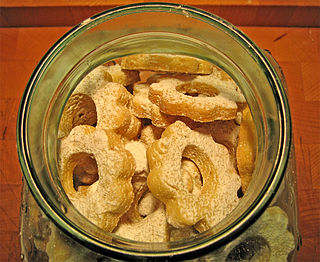 W
WCanestrelli are a type of Italian biscuit. Originating in Monferrato, the biscuits are common in both Piedmont and Liguria. Moreover, under the name Canistrelli, they are also typical of Corsica.
 W
WChiffonade is a slicing technique in which leafy green vegetables such as spinach, sorrel, or Swiss chard, or a flat-leaved herb like basil, are cut into long, thin strips. This is accomplished by stacking leaves, rolling them tightly, then slicing the leaves perpendicular to the roll. The technique can also be applied to thin crepes or omelets to produce strips.
 W
WChocolatera is a type of high-necked metal pot shaped like a pitcher used for the traditional preparation of hot chocolate drinks in Spain, Latin America, and the Philippines. It is used in combination with a molinillo baton to froth the chocolate.
 W
WIn cooking, to coddle food is to heat it in water kept just below the boiling point. In the past, recipes called for coddling fruit, but in recent times the term is usually only applied to coddled eggs. The process is either done in a regular pan or pot, or through the use of a special device such as an "egg coddler".
Concasse, from the French concasser, "to crush or grind", is a cooking term meaning to rough chop any ingredient, usually vegetables or fruit. This term is particularly applied to tomatoes, where tomato concasse is a tomato that has been peeled, seeded, and chopped to specified dimensions. Specified dimensions can be rough chop, small dice, medium dice, or large dice. The most popular use for tomato concasse is in an Italian bruschetta, typically small dice concasse mixed with olive oil and fresh basil, and sometimes other ingredients such as onion, olives, or anchovies.
 W
WCrinkle-cutting is slicing that leaves a corrugated surface.
 W
WDicing is a culinary knife cut in which the food item is cut into small blocks or dice. This may be done for aesthetic reasons or to create uniformly sized pieces to ensure even cooking. Dicing allows for distribution of flavour and texture throughout the dish, as well as a somewhat quicker cooking time. Dicing usually applies to vegetables prepared in this way but it can also apply to the preparation of meat or fish and fruit. Brunoise is an especially small size, produced from further cutting of julienne-style food.
 W
WDry roasting is a process by which heat is applied to dry foodstuffs without the use of oil or water as a carrier. Unlike other dry heat methods, dry roasting is used with foods such as nuts and seeds, in addition to some eaten insects such as house crickets. Dry-roasted foods are stirred as they are roasted to ensure even heating.
 W
WEngastration is a cooking technique in which the remains of one animal are stuffed into another animal. The method supposedly originated during the Middle Ages. Among the dishes made using the method is turducken, which involves placing chicken meat within a duck carcass within a turkey. Some foods created using engastration have stuffing between each layer. The carcasses are normally deboned before being placed together.
 W
WGinisang munggo is a Filipino savory mung bean soup. It is made with mung beans, garlic, tomatoes, onions, various vegetables, and patis. It is cooked with pork, tinapa, daing, or other seafood and meat. It is also commonly garnished with chicharon. The name means "sauteed mung bean", though the dish ends up being a soup. The name is in reference to the first step of the cooking process where the spices and the secondary ingredients are sauteed before water and the mung beans are added.
 W
WHasselback potatoes or Potato à la Hasselbacken are a type of baked potato, where they are cut about halfway through into thin fan-like slices.
 W
WA hexamine stove, or hexi-stove, is a cooking stove that uses hexamine fuel tablets. The fuel tablets are also known as hexamethyl-enetetramine or methenamine. The stove's function is use in emergency situations. It acts as a platform for cooking and windbreak for such cooking. The hexamine stove is designed to fold into a compact size for storage.
 W
WLaminated dough is a culinary preparation consisting of many thin layers of dough separated by butter, produced by repeated folding and rolling. Such doughs may contain over eighty layers. During baking, water in the butter vaporizes and expands, causing the dough to puff up and separate, while the lipids in the butter essentially fry the dough, resulting in a light, flaky product. Examples of laminated doughs include:Croissant pastry Danish pastry Flaky pastry Jachnun Kubaneh Paratha Puff pastry
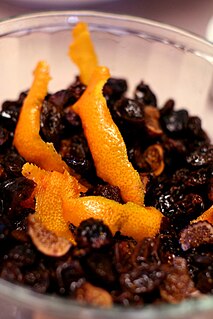 W
WIn food preparation, maceration is softening or breaking into pieces using a liquid.
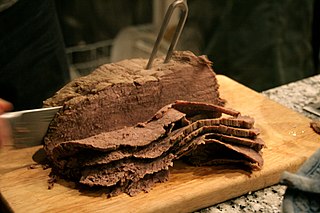 W
WMeat carving is the process and skill of cutting portions of meat, such as roast and poultry, to obtain a maximum or satisfactory number of meat portions, using a carving knife or meat-slicing machine. A meat carver disjoints the meat and slices in uniform portions. Meat carving is sometimes considered a skill for the private dinner table.
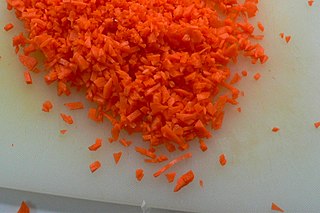 W
WMincing is a food preparation technique in which food ingredients are finely divided into uniform pieces. Minced food is in smaller pieces than diced or chopped foods, and is often prepared with a chef's knife or food processor, or in the case of meat by a specialised meat grinder.
 W
WMulling spices is a spice mixture used in drink recipes. The spices are usually used to spice hot apple cider, mulled wine, wassail, hippocras and other drinks during autumn or winter. A "mulled" drink is a drink which has been prepared with these spices. Mulling spices may also be added to the brewing process to make spiced beer.
 W
WNappage or apricot glaze is a baking technique. Jam made from apricots is diluted with water to form a transparent, slightly apricot-colored glaze. The glaze is used to cover fruit on a fruit tart or other baked goods, to make the fruit pieces shiny, prevent them from drying out, and to retard oxidation.
 W
WPaksiw is a Filipino style of cooking, whose name means "to cook and simmer in vinegar." Common dishes bearing the term, however, can vary substantially depending on what is being cooked.
 W
WParboiling is the partial or semi boiling of food as the first step in cooking. The word is from the Old French 'parboillir' but by mistaken association with 'part' it has acquired its current meaning.
 W
WA pastry blender is a cooking utensil used to mix a hard (solid) fat into flour in order to make pastries. The tool is usually made of narrow metal strips or wires attached to a handle, and is used by pressing down on the items to be mixed. It is also used to break these fats into smaller pieces. The blending of fat into flour at this stage impacts the amount of water that will be needed to bind the pastry into a dough.
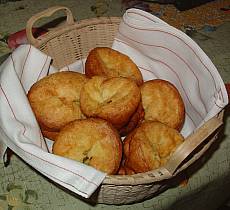 W
WA popover is a light roll made from an egg batter similar to that of Yorkshire pudding, typically baked in muffin tins or dedicated popover pans, which have straight-walled sides rather than angled.
 W
WIn cooking, reduction is the process of thickening and intensifying the flavor of a liquid mixture such as a soup, sauce, wine, or juice by simmering or boiling.
 W
WReverse spherification is a method of molecular gastronomy. This method is similar to spherification, different in that it is used to enclose liquid containing alcohol content, as well as liquid with calcium content such as milk and yogurt. When the liquid containing alcohol or calcium salt is dropped into an alginate bath, the liquid will draw itself into a spherical shape and becomes encapsulated by the gel-like membrane formed by the cross-linking of the calcium ions and the alginate polymer strands. Larger spheres can be created using reverse spherification. After removing the jelly from the alginate bath, calcium would not continue to diffuse into the center of the sphere, therefore would not create a gel center. Longer storage time could be obtained for this product accordingly.
 W
WRicing is a cooking term meaning to pass food through a food mill or "ricer", which comes in several forms. In the most basic, food is pushed or pressured through a metal or plastic plate with many small holes, producing a smoother result than mashing, but coarser than pureeing or passing through a sieve or tamis. The size of the product produced by ricing is about the same as grains of rice.
 W
WSeparating eggs is a process, generally used in cooking, in which the egg yolk is removed from the egg white. This allows one part of the egg to be used without the other part, or each part to be treated in different ways. Recipes for custard call for egg yolks, for example.
 W
WShocking is a cooking process wherein the food substance, usually a vegetable or fruit, is plunged into iced water or placed under cold running water to halt the cooking process.
 W
WShort order cooking, in the restaurant business, is the preparation of foods that are quick to cook. Many small restaurants serve only short-order items, which include fried, broiled, griddled foods, as well as assembled foods like sandwiches.
 W
WShrivelling is a natural phenomenon where an object, with an attached sub-elastic covering, has its interior volume reduced in some way. The covering, which cannot contract any further, is then obliged to wrinkle and buckle, in order to preserve surface area while containing the lesser volume.
 W
WSimmering is a food preparation technique by which foods are cooked in hot liquids kept just below the boiling point of water and above poaching temperature. To create a steady simmer, a liquid is brought to a boil, then its heat source is reduced to a lower, constant temperature.
 W
WSinangág, also called garlic fried rice or garlic rice, is a Filipino fried rice dish cooked by stir-frying pre-cooked rice with garlic. The rice used is preferably stale, usually leftover cooked rice from the previous day, as it results in rice that is slightly fermented and firmer. It is garnished with toasted garlic, rock salt, black pepper and sometimes chopped scallions. The rice grains are ideally loose and not stuck together.
 W
WSpherification is a culinary process that employs sodium alginate and either calcium chloride or calcium glucate lactate to shape a liquid into squishy spheres, which visually and texturally resemble roe. The technique was documented by Unilever in the 1950s and brought to the modernist cuisine by the creative team at El Bulli under the direction of chefs Ferran Adrià and Albert Adrià.
 W
WSweating in cooking is the gentle heating of vegetables in a little oil or butter, with frequent stirring and turning to ensure that any emitted liquid will evaporate. Sweating usually results in tender, sometimes translucent, pieces. Sweating is often a preliminary step to further cooking in liquid; onions, in particular, are often sweated before including in a stew. This differs from sautéing in that sweating is done over a much lower heat, sometimes with salt added to help draw moisture away, and making sure that little or no browning takes place.
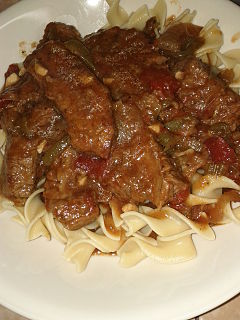 W
WSwiss steak is a dish of meat, usually beef, that is swissed by rolling or pounding before being braised in a cooking pot of stewed vegetables and seasonings. It is often served with gravy. It is made either on a stove or in an oven, and does not get its name from Switzerland, as the name suggests, but the technique of tenderizing by pounding or rolling called "swissing".
 W
WTangia is an urn-shaped terra cotta cooking vessel. It is also the name of the stew cooked in the pot. It is common in Marrakech, Morocco.
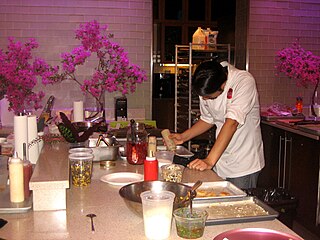 W
WA test kitchen is a kitchen used for the process of developing new kinds of food. On the largest scale, they are run by the research and development departments of large companies in the food industry. Other test kitchens are owned by individuals who enjoy the craft of developing new recipes.
 W
WTinapa, a Filipino term, is fish cooked or preserved through the process of smoking. It is a native delicacy in the Philippines and is often made from blackfin scad, or from milkfish, which is locally known as bangus.